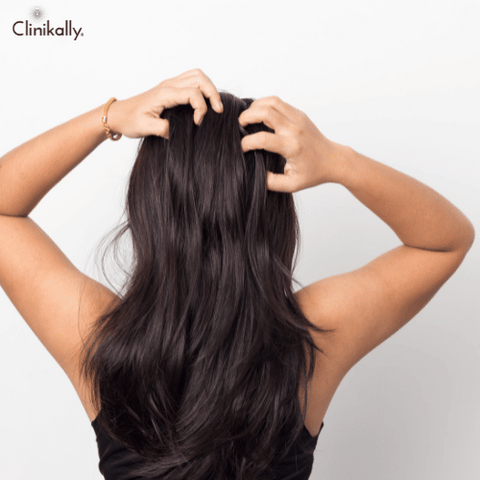Iron deficiency has been linked to hair loss because iron is a key component of the hair growth cycle. The hair growth cycle is divided into three stages: the anagen, catagen, and telogen phases. During the anagen phase, which lasts 2-6 years, hair actively grows from the hair follicle. Iron plays an essential role in the production of haemoglobin, a protein in red blood cells that carries oxygen to the body's tissues. Without adequate iron levels, there is insufficient haemoglobin to transport oxygen to the hair follicles, resulting in hair thinning and shedding.
Furthermore, the hair follicle shrinks and detaches from the blood supply during the catagen phase, which lasts 2-3 weeks. This is a normal part of the hair growth cycle and is required for new hair to grow. However, if the body is deficient in iron, the hair follicles may not receive enough oxygen and nutrients to complete this phase, resulting in weaker, more prone to breaking hair strands. Finally, the hair rests and falls out naturally during the telogen phase, which lasts 3-4 months. However, if iron levels are low, the hair follicles might not have enough nutrients to support new hair growth during the anagen phase, which would cause the telogen phase to last longer and cause more hair to shed.
Exploring the Role of Iron in the Body: From Haemoglobin to Hair Follicles

Iron is a necessary mineral that is required for many bodily functions. It is a component of haemoglobin, the protein in red blood cells that carries oxygen from the lungs to the rest of the body. Iron is necessary for the synthesis of several enzymes involved in producing and metabolising energy as well as the protein myoglobin, which stores oxygen in muscle tissue. Iron is essential for the immune system in addition to its role in oxygen transport. It helps the body fight infections and other diseases by assisting in the production of white blood cells.
Iron is also necessary for the proper development and function of the brain. It is involved in the production of neurotransmitters, the chemicals that allow nerve cells to communicate with each other. Iron deficiency has been linked to cognitive dysfunctions such as memory and attention deficits. In terms of hair follicles, as mentioned earlier, iron is crucial for the growth and development of hair. If the body does not have enough iron, the hair follicles may not be able to complete the various phases of the hair growth cycle, which can lead to thinning and hair loss. Iron is found in many foods, including red meat, poultry, fish, and leafy green vegetables. It can also be taken as a dietary supplement. However, it is important to note that excessive iron intake can be harmful and lead to various health problems. It is therefore recommended to consult a healthcare provider before taking iron supplements.
The Importance of Iron for Oxygenation, Metabolism, and Immune Function
The mineral iron is necessary for the body's metabolism, immune system, and oxygenation. The protein haemoglobin, which is found in red blood cells and carries oxygen from the lungs to the body's tissues, needs to be synthesised in order to function. Iron is also involved in the production of myoglobin, a protein found in muscles that helps store and use oxygen during exercise. The production of energy from food is one of the many metabolic processes for which iron is a necessary component. It helps convert food into energy and is involved in the synthesis of DNA and other important molecules.
In addition to its roles in metabolism and oxygenation, iron is crucial for immune function. It is necessary for the growth and operation of immune cells that support the body's defence against illnesses and infections, such as T cells and natural killer cells. A frequent nutritional problem is iron deficiency, which affects people who follow vegetarian or vegan diets, young children, pregnant women, and people who are vegetarian or vegan. Anaemia, a condition where there are not enough red blood cells to carry oxygen to the body's tissues, can result from an iron deficiency. The signs of anaemia include weakness, fatigue, and shortness of breath.
The Connection Between Iron Deficiency and Anaemia: Symptoms and Causes
Iron deficiency is a common cause of anaemia, a condition in which the body does not have enough red blood cells to transport oxygen to the tissues. Fatigue, weakness, shortness of breath, dizziness, and headaches are all symptoms of anaemia. In severe cases, anaemia can lead to organ damage and even death. Iron is necessary for the production of haemoglobin, a protein found in red blood cells that carries oxygen from the lungs to the body's tissues. When the body does not have enough iron, it cannot produce enough haemoglobin, leading to a decrease in the number of red blood cells.
There are a number of causes for iron deficiency anaemia, including:
-
Iron deficiency: Iron is present in many foods, including red meat, poultry, fish, beans, lentils, tofu, and fortified cereals. If vegetarians or vegans do not consume enough iron-rich plant foods or fortified foods, they may be more at risk of iron deficiency.
-
Increased iron requirements: Children and pregnant women are more at risk of iron deficiency because their bodies need more iron for growth and development.
-
Blood loss: Chronic blood loss can lead to iron deficiency anaemia. This might happen as a result of severe menstrual bleeding, gastrointestinal bleeding, or other bleed-related medical conditions.
-
Impaired absorption: Some medical conditions, such as celiac disease or inflammatory bowel disease, can impair the body's ability to absorb iron from food.
-
Lack of ability to store iron: People with genetic diseases like thalassemia or sickle cell anaemia may experience problems storing and using iron, which increases their risk of developing iron deficiency anaemia.
The Effects of Iron Deficiency on Hair Growth Cycle and Hair Follicles
A lack of iron can affect the hair growth cycle and follicles, which can cause hair loss and other issues with the hair. Iron is a necessary mineral for the synthesis of haemoglobin, a protein found in red blood cells that transports oxygen to tissues throughout the body, including hair follicles. The synthesis of enzymes and other molecules that promote hair growth also involves iron. When the body is iron deficient, it may shift the available iron away from hair growth and toward more important processes like oxygen transport. This may interfere with the cycle of hair growth and cause hair loss.
An iron deficiency can also have an impact on the structure and operation of hair follicles. There is less hair follicle density and hair shaft thickness in iron-deficient people, according to studies. A lack of iron can also cause hair follicles to enter the resting phase of the hair growth cycle earlier than usual, which leads to hair loss and thinning. In addition to hair loss, iron deficiency can also cause other hair-related problems, such as brittle, dry, or dull hair. This is due to iron's role in sebum production, an oily substance that hydrates and safeguards the scalp and hair. It is important to note that other factors can also contribute to hair loss and hair-related problems, such as genetics, hormonal imbalances, stress, and certain medications. An in-depth examination must be performed by a healthcare professional in order to identify the cause of hair issues and create a successful treatment plan.
Distinguishing Between Telogen Effluvium and Other Types of Hair Loss

Temporary hair loss known as telogen effluvium (TE) happens when the regular cycle of hair growth is thrown off. The majority of hairs on the scalp are in the growth phase (anagen phase), but approximately 10-15% are in the resting phase (telogen phase). Telogen effluvium occurs when telogen hairs are shed excessively, resulting in diffuse hair thinning. However, it can sometimes be difficult to distinguish telogen effluvium from other forms of hair loss. Here are some ways to tell telogen effluvium from other types of hair loss:
-
Androgenetic alopecia (AGA): AGA is a common, hereditary type of hair loss that typically impacts both men and women as they age. It typically manifests as a thinning crown or a receding hairline. AGA, in contrast to telogen effluvium, is a chronic condition that worsens over time and causes a gradual loss of hair density.
-
Alopecia areata: Alopecia areata is an autoimmune disorder that results in patchy hair loss. It can affect the scalp, brows, beard, or any other area of the body that has hair. In contrast to telogen effluvium, alopecia areata typically manifests as circular patches of hair loss.
-
Traction alopecia: Tight hairstyles or hair extensions can cause hair loss due to constant pulling or tension on the hair. It frequently manifests as hair loss in areas where the hair has been pulled tightly, such as the hairline. Contrary to telogen effluvium, traction alopecia frequently affects only a few spots on the scalp.
-
Anagen effluvium: This type of hair loss happens when the hair follicles are damaged, usually due to chemotherapy or radiation treatment. Anagen effluvium manifests as abrupt and severe hair loss, in contrast to telogen effluvium.
The Mechanisms of Telogen Effluvium and Its Relationship to Nutrient Deficiencies
Telogen effluvium (TE) is a type of hair loss that occurs when there is a disruption in the normal hair growth cycle. Typically, hairs on the scalp go through a cyclic process of growth, transition, and resting phases. Telogen effluvium is characterised by an increase in the number of hair follicles in the dormant (telogen) phase, which leads to hair loss and thinning. There are a number of factors that have been linked to the development of telogen effluvium, though the mechanisms underlying it are not fully understood. Because stress causes hair follicles to prematurely enter the telogen phase, it is one of the main causes of TE. Surgery, illness, and childbirth are examples of physical stressors. Anxiety and depression are examples of emotional stressors.
Nutrient deficiencies can also contribute to telogen effluvium. In particular, deficiencies in iron, zinc, and biotin have been linked to hair loss and thinning. Iron is required for the production of haemoglobin, which transports oxygen to tissues throughout the body, including hair follicles. Zinc is essential for hair growth because it is involved in DNA and protein synthesis. Biotin is a B vitamin that is required for the metabolism of amino acids, which are the building blocks of proteins such as keratin, the protein found in hair. Other nutrient deficiencies linked to hair loss and thinning include vitamin D, vitamin B12, and selenium deficiencies. In addition, illnesses like celiac disease that result in malabsorption syndromes can impair the absorption of nutrients, causing nutrient deficiencies and hair loss. Nutrient deficiencies can also cause telogen effluvium, but these are not the only causes of the condition. Hormonal disorders, medication use, and autoimmune diseases are some additional causes of telogen effluvium. To find out the underlying cause and the best course of action if you are balding or experiencing hair thinning, it is crucial to seek medical advice. To identify the type of hair loss and identify any nutrient deficiencies that might be exacerbating the condition, a healthcare professional can conduct a thorough evaluation that includes a physical exam and blood tests.
The Differences Between Telogen Effluvium, Androgenetic Alopecia, and Alopecia Areata
Telogen effluvium (TE), androgenetic alopecia (AGA), and alopecia areata (AA), three different types of hair loss, each with their own causes, symptoms, and treatments.
-
Telogen effluvium (TE) is a transient type of hair loss that happens when the regular cycle of hair growth is disturbed. Around 10-15% of hairs on the scalp are in the resting phase (telogen phase), but the majority of hairs are in the growth phase (anagen phase). TE is characterised by increased telogen hair shedding, which causes diffuse hair thinning. The use of medications, illness, hormonal changes, and nutrient deficiencies are some of the factors that contribute to TE. After the underlying cause has been addressed, TE typically goes away on its own within a few months.
-
Androgenetic alopecia (AGA) is a common type of hereditary hair loss that typically impacts both men and women as they get older. Genetic, hormonal, and environmental factors all contribute to its development. The most common symptoms of AGA include a thinning crown and receding hairline, along with a gradual loss of hair density. Treatment options for AGA, a chronic and progressive condition, include drugs like minoxidil and finasteride as well as hair transplant surgery.
-
Alopecia areata (AA) is an autoimmune condition that results in patchy hair loss on the scalp and other parts of the body where there is hair. Hair loss happens as a result of the immune system attacking hair follicles. The severity and pattern of hair loss can vary with AA, which can affect people of all ages and genders. Topical or intravenous corticosteroids, immunosuppressive drugs, or hair transplant surgery are all possible treatments for AA.
The Need for Accurate Diagnosis and Treatment Planning
Accurate diagnosis and treatment planning are required for effective hair loss management. There are numerous types of hair loss, each with its own unique causes and treatments, and incorrect diagnosis or treatment plans can cause unnecessarily long delays in getting the results you want. If nutrient deficiencies, such as a lack of iron or biotin, are the cause of hair loss, for example, a simple dietary supplement or modification may be all that is required to restore hair growth. However, more aggressive therapies might be needed if the root cause is a hormonal imbalance or an autoimmune condition like alopecia areata. It is also crucial to keep in mind that some treatments may have possible side effects, interact with other medications, or call for ongoing monitoring, and these risks must be carefully taken into account during the planning stage of the treatment.
Understanding the Diagnosis and Treatment of Iron Deficiency and Hair Loss

Iron supplements are frequently used to treat iron deficiency, a common cause of hair loss. However, a correct diagnosis is necessary to determine whether the iron deficiency is the root of hair loss. Iron deficiency is typically diagnosed through a blood test that measures the levels of haemoglobin, a protein in red blood cells that transport oxygen, and ferritin, a protein that stores iron. Low levels of ferritin or haemoglobin can indicate an iron deficiency. The treatment plan will typically call for iron supplementation once an iron deficiency has been identified. The type and quantity of iron supplements may change depending on the patient's particular requirements, the seriousness of the deficiency, and any underlying conditions. The most popular forms of iron supplements are ferrous sulphate, ferrous gluconate, and ferrous fumarate. It is essential to keep in mind that iron supplements should be taken with food to reduce the likelihood that they will make you feel queasy, nauseated, or upset your stomach. In order to prevent further iron deficiency and hair loss, the underlying cause must be found and treated. The fact that an underlying medical condition like celiac disease or inflammatory bowel disease can manifest as an iron deficiency is also very important to keep in mind.
The Laboratory Tests and Clinical Assessments for Iron Deficiency and Anaemia
Iron deficiency and anaemia are diagnosed and treated using laboratory tests and clinical assessments. Here are some examples of tests and assessments that could be used:
-
Complete blood count (CBC): This examination assesses the quantity of the body's various blood cells, such as platelets, white blood cells, and red blood cells. Anaemia can be identified by a low haemoglobin and red blood cell count.
-
Serum ferritin test: This test gauges the quantity of ferritin, a protein that stores iron. Low levels of ferritin may be a sign of an iron deficiency.
-
Iron and TIBC tests: These tests measure the levels of iron and transferrin, a protein that transports iron in the blood. Low iron levels and high TIBC levels can indicate iron deficiency.
-
Haemoglobin electrophoresis: This test is used to identify some anaemias, including thalassemia and sickle cell anaemia.
-
Bone marrow biopsy: In this procedure, a small sample of bone marrow is taken in order to evaluate the production and operation of blood cells.
-
Clinical evaluation: To assist in the diagnosis of anaemia and iron deficiency, a medical professional may also conduct a physical examination and review the patient's medical history. This may include assessing symptoms such as fatigue, weakness, and pale skin.
-
Additional tests: To rule out other conditions or check for underlying medical conditions that may be causing iron deficiency or anaemia, additional tests may be ordered based on the patient's particular needs and symptoms.
The Benefits and Risks of Iron Supplements and Other Treatments for Hair Loss
Hair loss brought on by an iron deficiency can be treated with iron supplements. They work by increasing iron levels in the body, which can improve oxygen and nutrient delivery to hair follicles and promote healthy hair growth. However, there are some dangers to taking iron supplements. High iron dosages have the potential to be toxic, and taking too much iron as a supplement can make you queasy, nauseous, and sick to your stomach. Follow your doctor's recommendations for iron supplements and keep an eye on your iron levels to prevent overdosing. Other treatments, in addition to iron supplements, may be used to promote hair growth and improve hair health. For instance, two medications for androgenetic alopecia (common hair loss) that have been approved by the FDA are topical minoxidil (Rogaine) and oral finasteride (Propecia). These treatments promote hair growth and slow the progression of hair loss. They can, however, cause side effects such as irritation of the scalp, dizziness, and decreased libido. Hair transplants, platelet-rich plasma (PRP) therapy, and laser therapy are some other treatments that may be used to promote hair growth. These treatments vary in their effectiveness and come with their own set of risks and side effects.
The Role of Dietary Sources of Iron, Lifestyle Modifications, and Follow-Up Monitoring
In addition to iron supplements and other medical treatments, there are also dietary sources of iron that can be incorporated into a healthy diet to help prevent and treat iron deficiency and hair loss. Foods that are rich in iron include red meat, poultry, fish, legumes, leafy green vegetables, whole grains, iron-fortified cereals, and bread.
Some foods, such as dairy products, tea, and coffee, can inhibit iron absorption and should be consumed in moderation. Vitamin C-rich foods, such as citrus fruits, can aid in iron absorption. Along with dietary modifications, some lifestyle adjustments may help prevent and treat hair loss. For example, stress reduction, regular exercise, and staying away from harsh chemical treatments and hairstyles can all support healthy hair growth and stop further hair loss.
Exploring the Possible Complications and Underlying Causes of Iron Deficiency and Hair Loss

The relationship between iron deficiency and hair loss is complicated by a number of underlying causes and potential side effects. Some of these issues include weakness and exhaustion, weakened immune system, children's delayed growth and development, impaired cognitive function, increased risk of infection, and issues during pregnancy.
The following are the underlying causes:
-
Inadequate consumption of foods high in iron
-
Deficiencies in digestion or malabsorption
-
Blood loss from injuries or chronic conditions like heavy menstrual bleeding or gastrointestinal bleeding
-
Breastfeeding or being pregnant
-
Using specific medications, like proton pump inhibitors or antacids
-
Long-term kidney disease
-
Certain autoimmune disorders, such as celiac disease or rheumatoid arthritis
The Link Between Inflammation, Autoimmune Disorders, and Iron Absorption
Iron deficiency can result from inflammation and autoimmune disorders that impair iron absorption. Cytokines, which are proteins that can block the use and absorption of iron, are produced during inflammation. This is due to the ability of cytokines to suppress the expression of hepcidin, a hormone that regulates the body's iron metabolism and absorption. Autoimmune conditions like celiac disease and inflammatory bowel disease can also impair iron absorption. These conditions can cause damage to the lining of the small intestine, resulting in iron malabsorption. Chronic inflammation that results from autoimmune disorders can further obstruct the absorption and utilisation of iron. When inflammation and autoimmune disorders are causing iron deficiency and hair loss, it's critical to treat the underlying condition to increase iron absorption and stop further hair loss. A doctor might suggest taking medication, altering your diet, or adopting a new lifestyle.
The Genetic Factors and Family History of Iron Deficiency and Hair Loss
Genetic factors and family history may play a role in the development of iron deficiency and hair loss, according to evidence. Inherited genetic mutations that can impact iron metabolism and absorption can increase the risk of iron deficiency. For instance, mutations in the HFE gene, which regulates iron absorption, can result in hereditary hemochromatosis, a condition in which too much iron accumulates in the body. In a manner similar to this, genetic factors may be involved in hair loss. The most common type of hair loss, androgenetic alopecia, is known to have a strong genetic component. Hair follicles in this condition are genetically predisposed to shrink over time and produce thinner, shorter hairs.
A person's family history can also provide important information about his or her risk of developing an iron deficiency or hair loss. If a family member has been diagnosed with one of these conditions, it is worth talking to a doctor about it and considering screening tests to assess iron levels and identify any underlying genetic factors. The detection and treatment of any underlying conditions can help prevent further problems and improve overall health outcomes, despite the fact that genetic factors cannot be changed. A healthy diet, regular exercise, and stress management can all help to promote healthy hair growth and avoid iron deficiency.
The Importance of Comprehensive Evaluation and Management of Iron Deficiency and Associated Conditions
Comprehensive evaluation and management of iron deficiency and associated conditions is important for several reasons:
-
Accurate diagnosis: A thorough examination can assist in determining the root cause of iron deficiency and hair loss, which may include a combination of genetic, lifestyle, and environmental factors.
-
Customised care: By determining the root cause of the iron deficiency and hair loss, medical professionals can better adapt treatment strategies to meet the unique requirements of each patient. This could entail dietary adjustments, dietary supplements, medication, and lifestyle adjustments.
-
Complication avoidance: Iron deficiency and hair loss can be treated early on to stop further issues from developing, like anaemia, fatigue, and a weakened immune system.
-
Improved quality of life: By easing symptoms, boosting energy levels, and encouraging healthy hair growth, treatment of iron deficiency and hair loss can help improve overall health outcomes and quality of life.
-
Monitoring of progress: Follow-up appointments and monitoring on a regular basis can help make sure that the treatment is working and spot any emerging problems.
Conclusion

In order to promote overall health and prevent complications, iron deficiency, a common condition that can result in hair loss, must be treated. A thorough investigation of the underlying causes of iron deficiency and hair loss, including genetic, environmental, and lifestyle factors, is necessary for proper diagnosis and treatment. Treatment options could involve altering one's diet, taking extra iron, taking medication, changing one's lifestyle, and attending to any underlying conditions that might be making the issue worse. Regular monitoring and follow-up visits can help ensure that the treatment is effective and spot any emerging or new problems that may need to be addressed. By using a comprehensive approach to evaluation and management, healthcare professionals can assist their patients in achieving healthy hair growth as well as overall health and well-being.
















